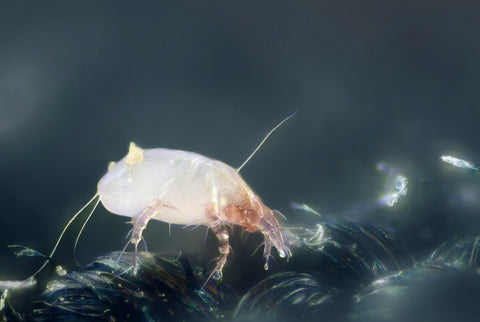Homes collect LOTS of dust. In fact, the average home collects 40 lbs of dust a year. Contrary to popular belief, dust is more than just dirt. It is a mix of dead skin cells, hair, food particles (like flour!) clothing fibers, bacteria, dust mites, bits of dead bugs, pollen, and microscopic particles of plastic. Two thirds of it comes from outside when it gets tracked in on your shoes as dirt and from airborne particles such as soot and pollen.
Difference between Dust and Dust Mites
Many people think they are the same but not really. Dust is a mix of skin, hair, pollen, etc while dust mites are actually microscopic, living, insect-like creatures that feed on dead human skin cells. They are found in mattresses, sheets, carpets and curtains. Nearly 4/5 of homes in North America have dust mites in at least one bed.

One dust mite can leave behind thousands of waste particles in one gram of dust and can trigger allergic reactions in people.
Mites can live on humans completely unnoticed, an infestation can lead to symptoms such as itching and red bumps.

Example of dust mite bites.
Is Dust Harmful to your Health?
It can be! When dust gets disturbed, it gets suspended into the air and can get breathed in.
The smallest of airborne particles can bypass the natural defenses in your nose and make it all the way to your alveolar which is the deepest part of your lungs. This is the place where oxygen is added to your bloodstream. Anything that makes it here, whether it’s oxygen, dust or virus will then be transported throughout your body which is where the trouble starts since they can end up in your brain and heart causing serious health damage. Recent studies are now showing that dust can contain up to 40 different dangerous chemicals. Dust gets trapped in carpets and crevices, so dust in an old house can even retain pollutants such as DDT that were banned nearly fifty years ago!
DEHP: This toxic chemical was found in nearly every dust sample studied. It is found in food containers, electronics and vinyl floors. Disrupts hormones and is harmful to reproductive system.
TDCIPP: A flame retardant found in some furniture. Known carcinogen.
Phenols: Found in a variety of cleaning products. Disrupts hormones and is harmful to reproductive system.
Symptoms that Indicate you may be Allergic to Dust
- Sneezing
- Runny nose
- Skin irritations
- Red, itchy eyes
- Coughing
Surface Dust versus Airborne Dust: How to Remove All Dust
Removing dust from your home involves a two-pronged approach. You first need to address the surface dust which is settled dust that you find on floors, furniture and walls. This can be done with a vacuum cleaner equipped with HEPA filtration. The more surface dust you are able to remove, the cleaner your air will be since there will be less dust having the opportunity to get recirculated into your air. It is important to note that an air purifier cannot remove surface dust. Cities also contain a lot more dust due to construction and lack of forest area to absorb dust particles.
The second source of dust is airborne dust. This is dust that an air purifier with a HEPA filter can remove.
- Mopping should be done weekly to remove dust and grime from floors
- Using rubber gloves, rub your hands over the surface of upholstered sofas and curtains to create static cling and extract dust, dander, hair. Next, vacuum thoroughly. This should be done a few times per month.
- Dust mites thrive in high temperatures and high humidity since it helps them to breed and multiply easily. Kill them by washing linen in hot water (130F or 54.4 C) with 5-6 teaspoons of vinegar. Keep humidity levels below 50% and set temperatures no higher than 68 °F (20 °C)
- Books can be a HUGE source of dust! 3-4 times per year, you should vacuum the tops and spines of your books.
- Buy furniture made without flame retardants
- Choose cleaning products that don’t contain bleach or fragrance which tend to contain phthalates.
- Studies have shown that cloves can help control dust mites. The oil can be diffused into the air or sprayed directly onto fabrics.
- An air purifier with a High Efficiency Particulate Air filter (HEPA) with a good prefilter will help filter out 99.97% of airborne particles as small as 0.3 microns. Getting an ULPA filter is even better since it can filter 99.9999% of airborne particles as small as 0.1 microns. It should be run at low to medium speeds 24 hours a day.
Here are some common household pollutants and their corresponding micron sizes that can be removed with an air purifier
Pet dander: 2.5 -10 microns
Household dust: 0.5 -100 microns
Bacteria: 0.3 -60 microns
Pollen: 10-1000 microns


